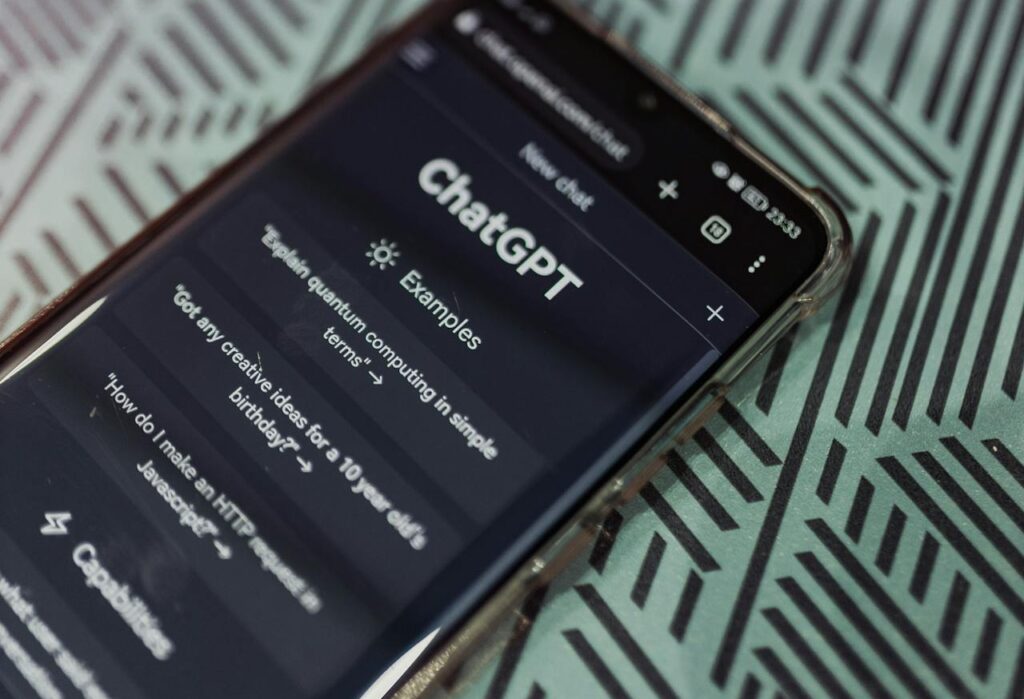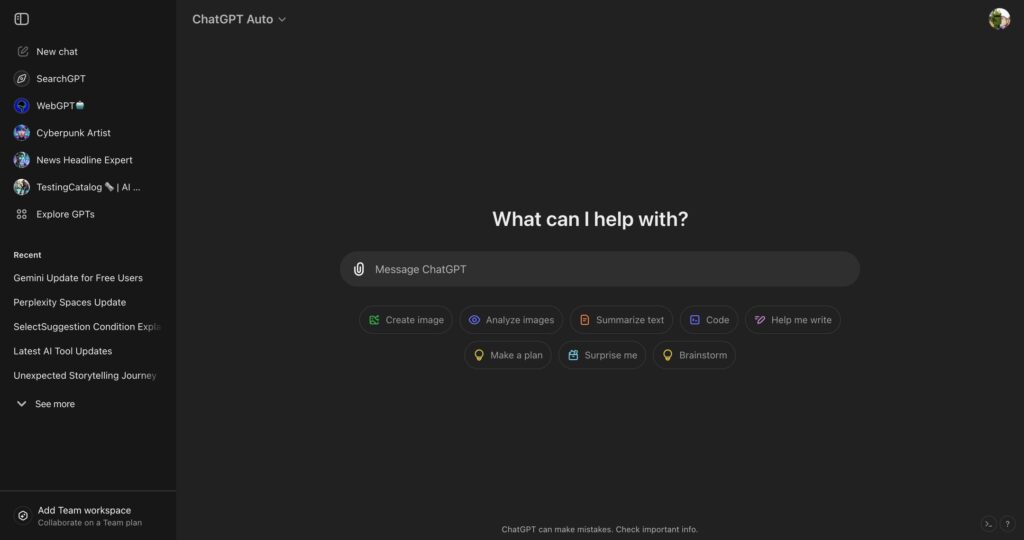Have you heard the buzz about Artificial Intelligence? It feels like it’s everywhere. The global AI market is already worth around $391 billion. Experts project it will grow five times larger in the next few years.
This isn’t just a distant tech trend. It’s happening right now, on our phones and computers.
The perfect example is ChatGPT. This tool gained one million users in just five days. Now, billions of people visit it every month.
Businesses are also jumping on board. A huge 83% of companies say AI is a top priority in their plans. In fact, 78% of organizations already use AI in some way.
Feeling a little behind? Don’t worry. You’ve come to the right place.
This is your complete ChatGPT beginner’s guide. We will walk you through everything, step by step.
You will learn what this powerful AI chatbot is. And you will learn how to start using it today. Let’s get started.
Contents
What is ChatGPT, Anyway?

So, what exactly is ChatGPT? Imagine you have a super-smart assistant. This assistant has read a massive part of the internet. You can ask it almost anything. It can answer questions, write emails, and explain complex topics. That, in a nutshell, is ChatGPT.
It’s an AI chatbot created by a company called OpenAI. The “GPT” in its name stands for Generative Pre-trained Transformer.5 That sounds complicated, so let’s break it down simply.
- Generative: It can create, or generate, new text from scratch.
- Pre-trained: It learned from huge amounts of text before you ever spoke to it.
- Transformer: This is the special tech that helps it understand context.
It’s important to know how it “thinks.” ChatGPT doesn’t understand things like a human does. It’s an expert pattern-matcher. It predicts the next most likely word in a sentence based on all the data it learned. This makes it incredibly powerful. But it also means it can sometimes make mistakes. We’ll talk more about that later.
Getting Started: Your First 5 Minutes with ChatGPT

Ready to give it a try? Getting started is fast and free. You can be up and running in just a few minutes. Follow these simple steps.
Step 1: Create Your Free Account
First, you need to create an account. It’s a straightforward process.
- Open your web browser and go to chat.openai.com.
- Click the “Sign up for free” button.
- You can enter your email address. Or, you can use your Google, Microsoft, or Apple account to sign up faster.
- Create a secure password. It needs to be at least 12 characters long.
- OpenAI will send you a verification email. Open it and follow the instructions.
- Finally, enter your name and date of birth to finish.
That’s it! You’re officially in.
Step 2: A Quick Tour of the Interface

When you first log in, the screen is clean and simple. Don’t let it intimidate you. Here are the main parts you need to know.
- The Prompt Bar: This is the most important part. It’s the text box at the bottom of the screen. This is where you will type your questions and requests (called “prompts”).
- The Main Chat Window: This is the large central area. Your conversation with ChatGPT will appear here.
- The Left-Hand Panel: Here you will find your chat history. ChatGPT automatically saves every conversation. You can come back to them later. You can also rename or delete them here.
- The Settings Menu: Click on your name in the bottom-left corner. This opens the settings. You can manage your account or switch to dark mode from here.
The Art of the Ask: A Guide to Writing Great Prompts

You are now ready to start chatting. The secret to getting great results from ChatGPT is learning how to ask great questions. This is the core of this ChatGPT beginner’s guide. A vague prompt will give you a generic answer. A specific prompt will give you a fantastic one.
Here are four simple principles to follow.
Principle 1: Be Specific and Give Context
The AI needs details to give you a helpful response. Tell it exactly what you need.
Bad Prompt: “Write about marketing.”
Good Prompt: “Develop a five-step digital marketing plan for a new coffee shop. The target audience is college students. The budget is $500.”
Principle 2: Assign a Role
This is a powerful trick. Tell ChatGPT to act as an expert. The quality of the response will improve dramatically.
Bad Prompt: “Help me write an email.”
Good Prompt: “Act as a project manager. Draft a follow-up email to a client. The email should summarize our meeting and list the next steps.”
Principle 3: Provide Examples
You can show ChatGPT what you want. Give it an example of the style or format you’re looking for. This is called “few-shot prompting.”
Example Prompt: “Write a short, exciting Instagram caption about a new hiking trail. Use a style similar to this: ‘Adventure is calling! 🌲 Just conquered the Eagle Peak trail and the views were epic. #hiking #nature'”
Principle 4: Define the Format and Constraints
Tell the AI exactly how you want the answer structured. Do you want a list? A table? A short paragraph? Let it know.
Bad Prompt: “Explain artificial intelligence.”
Good Prompt: “Explain artificial intelligence in 100 words. Use simple language that a beginner can understand. Structure the answer as three bullet points.”
To make this even clearer, here is a quick comparison table.
Vague Prompt (What to Avoid)
Specific Prompt (What to Do Instead)
Why It Works
“Create a workout plan.”
“Act as a personal trainer. Create a 3-day beginner workout plan for someone who wants to build muscle at home with no equipment.”
The role and specific constraints (beginner, home, no equipment) give the AI clear directions.
“Summarize this article.”
“Summarize this article in five key bullet points. Focus on the main arguments and the final conclusion.”
This defines the exact format (bullet points) and focus, resulting in a more useful summary.
“Give me business ideas.”
“Brainstorm five unique business ideas for an e-commerce store. The ideas should focus on sustainable products and have a startup cost under $1,000.”
Adding context (e-commerce, sustainable) and constraints (under $1,000) produces targeted, relevant ideas.
Mastering these principles is the key to unlocking ChatGPT’s full potential. It turns the tool from a simple search engine into a creative partner.
Putting Your AI Chatbot to Work: 10 Everyday Ideas to Try Now

Theory is great, but practice is better. The best way to learn is by doing. Here are 10 practical and fun ideas you can try right now. Copy and paste these prompts to see what this AI chatbot can do.
1. Plan a Week of Meals: “Act as a nutritionist. Create a 7-day meal plan for a busy professional who wants healthy, 30-minute dinners. Please include a shopping list.”
2. Draft a Professional Email: “Help me write a polite but firm email to a colleague who missed a deadline. The tone should be professional and collaborative.”
3. Learn Something New: “Explain the concept of quantum computing to me as if I were a 10-year-old.”
4. Brainstorm Creative Ideas: “I need 10 creative blog post titles for a website about urban gardening for beginners.”
5. Plan a Weekend Trip: “Act as a travel guide. Create a 2-day itinerary for a trip to Chicago on a budget of $200. Focus on free museums and cheap, delicious food.”
6. Get Workout Ideas: “Create a 20-minute, no-equipment workout routine I can do in my apartment to improve my flexibility.”
7. Summarize a Long Text: “Summarize the key points of this article in three bullet points: [Paste article text here].”
8. Practice for an Interview: “Let’s role-play a job interview. You are the hiring manager for a customer service position. Ask me five common interview questions.”
9. Write a Social Media Post: “Generate three engaging tweets about the benefits of drinking more water. Include relevant hashtags.”
10. Get Coding Help: “Explain what this small piece of Python code does and check it for simple errors: [Paste code here].”
Know the Rules: Key Limitations and Best Practices

Using ChatGPT is exciting. But it’s also important to be smart and safe. This tool has limitations. Understanding them will help you use it more effectively and responsibly.
1. Fact-Check Everything
ChatGPT can sometimes make mistakes. It can state incorrect facts with great confidence. This is often called an “AI hallucination”. Because it generates text based on patterns, it can create information that sounds plausible but is completely wrong.
Best Practice: Always verify important information. If you’re using it for research or work, double-check facts with reliable sources. Think of it as a brilliant but sometimes forgetful assistant.
2. The Knowledge Cutoff Date
The free version of ChatGPT does not know about recent events. Its knowledge was “cut off” at a certain point. For the standard free model, that date is usually a few months behind. It has no information about anything that happened after that time.
Best Practice: Don’t ask the free version about current news, recent movie releases, or the latest tech. It simply won’t know the answer.
3. Your Data and Privacy
This is the most important rule. By default, OpenAI may use your conversations to help train its models. Your chat history is saved to your account.
Best Practice: Never enter sensitive information. This includes passwords, bank account numbers, social security numbers, or private work information. Treat every conversation as if it could be read by someone else. It’s the safest way to protect your privacy.
Trending ChatGPT Guides: Don’t Miss
- The Ultimate ChatGPT Glossary: 60 Essential AI Terms Everyone Should Know
- Use ChatGPT at Work? These 10 Prompts Will Boost Your Productivity and Make You Look Like a Genius
- These 6 ChatGPT Prompts Make Your Old Social Media Posts Go Viral
- From Zero to Spreadsheet Genius: How I Use ChatGPT to Master Excel and Google Sheets
- These 7 Powerful ChatGPT Prompts Are Helping People Earn $100K+ Without a Degree
- 9 ChatGPT Hacks That Make You Work, Think, and Create Like a Pro (Unlock Its Full Potential)
- I Always Use This ChatGPT Trick to Easily Create PowerPoint Presentations 10x Faster
Your AI Journey Has Just Begun
You’ve made it! You now know what ChatGPT is and how it works. You’ve learned how to create an account and navigate the interface. Most importantly, you understand the art of writing a good prompt. This ChatGPT beginner’s guide has given you the foundation you need.
The world of AI is growing and changing fast. However, you already have a tool that can help you learn faster, create more easily, and be more productive. The journey doesn’t end here. It’s just beginning. The best way to keep learning is to stay curious and experiment.
So go ahead. Open a new chat. Ask your first question. Your adventure with ChatGPT starts now.